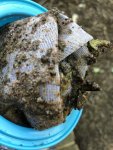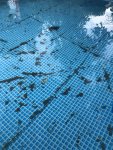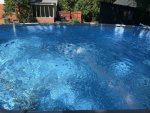I have a 15' above ground pool and following a week of intense storms, my chlorine levels dropped and the water became milky. I shocked the pool and used Leslie's UltraBright Advanced to clarify the water, with the expectation that I would be able to vacuum the muck. It;s been 10 days and I just cannot get rid of that muck! It settles on the floor, but any attempt at vacuuming puts it back in suspension in the water. I turn to the filter, but then it's settled back on the bottom...
I run the small Intex vacuum in various configurations, but invariably the "dust" gets kicked up and ends up in suspension. I am able to pick up brown "tree dust", ground up bark that falls on the bottom, but the white slimy residue remains in suspension, no matter how gentle I try to go. I have tried using a sock in my floating skimmer, tried using a leaf catcher with my vacuum (I have the Intex deluxe set), I even put goggles on and floated in the pool to hand-guide the head ever so gently over the debris. I collect a lot of the bark, but none of the slime. Meanwhile, my sand filter gets dirty and requires a backwash every day. The water coming out of the filter backwash is gray-white. Yet the bulk of the gunk remains on the bottom, even with the filter on, so not a lot of it is cleaned up.
I realize I should run the vacuum to bypass the sand and dump the water, but with my single-speed filter, I can empty the pool within minutes and still have the white muck in suspension.
I've tried to find some videos of the actual pool cleaning, but all I can find is how-tos on connecting the vacuum. none on actual operations, and the people at Leslie's recommended I simply run the pool filter longer. (It's already running 12h/day).
15'x48" Intex Prism pool, Intex floating skimmer, Intex 12" sand pump. Water parameters seem ok now -- Tested daily with a SwimMaster 5-testkit and confirmed at the store during the weekend. More storms on the horizon still... I need a better plan.
I run the small Intex vacuum in various configurations, but invariably the "dust" gets kicked up and ends up in suspension. I am able to pick up brown "tree dust", ground up bark that falls on the bottom, but the white slimy residue remains in suspension, no matter how gentle I try to go. I have tried using a sock in my floating skimmer, tried using a leaf catcher with my vacuum (I have the Intex deluxe set), I even put goggles on and floated in the pool to hand-guide the head ever so gently over the debris. I collect a lot of the bark, but none of the slime. Meanwhile, my sand filter gets dirty and requires a backwash every day. The water coming out of the filter backwash is gray-white. Yet the bulk of the gunk remains on the bottom, even with the filter on, so not a lot of it is cleaned up.
I realize I should run the vacuum to bypass the sand and dump the water, but with my single-speed filter, I can empty the pool within minutes and still have the white muck in suspension.
I've tried to find some videos of the actual pool cleaning, but all I can find is how-tos on connecting the vacuum. none on actual operations, and the people at Leslie's recommended I simply run the pool filter longer. (It's already running 12h/day).
15'x48" Intex Prism pool, Intex floating skimmer, Intex 12" sand pump. Water parameters seem ok now -- Tested daily with a SwimMaster 5-testkit and confirmed at the store during the weekend. More storms on the horizon still... I need a better plan.






